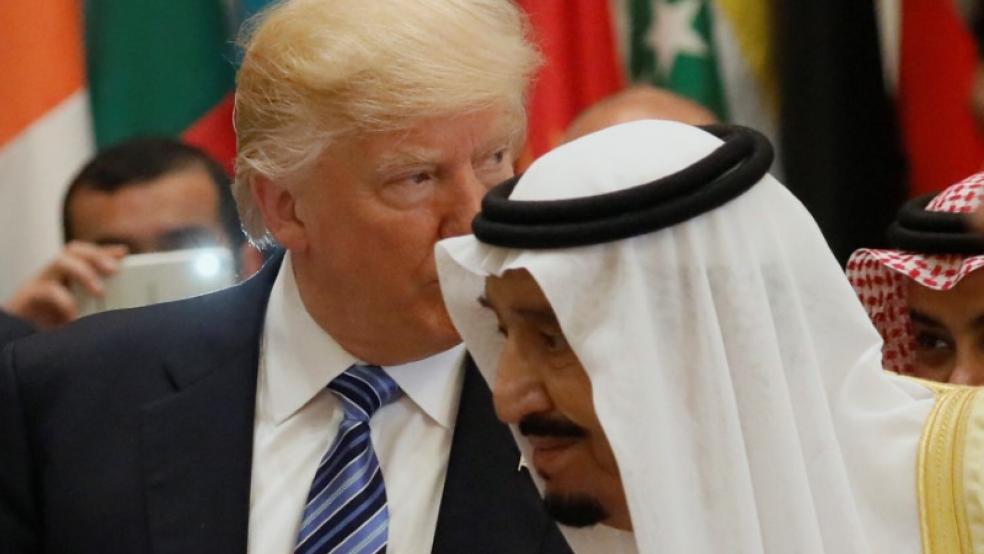It’s not likely that President Trump knew what he was getting into when he embraced the Saudis as the rightful leaders of the Islamic world and the war on terror during his visit to Riyadh last month. But there were plenty of trouble signs before King Salman named his ambitious, aggressively nationalist son Mohammed bin Salman crown prince as his all but certain successor.
The prince had already led the kingdom into a merciless sectarian war in Yemen, a sharpening conflict with Iran and a severe campaign of sanctions to isolate Qatar, which is another U.S. ally. This is not the man the U.S. should hitch its wagon to in the ever more complicated Middle East.
Related: How Saudi Arabia Is Killing Off OPEC
Nevertheless, Trump seems to have blundered into siding with the Saudis when he should have shown a more even hand.
Prince Mohammed’s promotion Wednesday over Mohammed bin Nayef, his older and more measured cousin, marks the most dramatic shakeup in the House of Saud’s 85–year history. It’s a generational shift that effectively passes power to a younger cohort in the royal family determined to assert Saudi (and Sunni) pre-eminence in the Arab world.
There are things to like about the 31–year-old Prince Mohammed, who has steadily increased his influence over foreign policy and the economy since his father became king three years ago. But there’s also plenty to worry about.
On the domestic side, the prince is a modernist—to a point, anyway. Last year he unveiled a radical plan to overhaul the Saudi economy. Vision 2030, is intended to diversify the nation’s heavy dependence on oil revenue while encouraging more private business investment.
Related: Iran’s Guards Says Saudi Arabia Behind Deadly Attacks in Tehran
Among Prince Mohammed’s more daring ambitions is to take Aramco, the Saudi national oil company, public by way of a stock offering. Depending on the long-term prospects for oil, the company could be worth between $1 and $1.5 trillion. Regardless, it would be the largest IPO in history if he pulls it off. (The FT has an Aramco IPO calculator here.)
Prince Mohammed’s a progressive—in relative terms, of course—in his social policies, too. He faces a fast-growing younger population that demands a loosening of the kingdom’s severe, antiquated social restrictions. The jobless rate among 20– to 29-year-olds was 28 percent in 2016—a number the prince surely has his eye on.
Washington would surely not oppose his effort to bring the economy and social mores at least partly into the 21st century.
But the heir apparent’s aggressive foreign policies present real problems for the U.S. The Saudis’ first mistake at least since the U.S. invasion of Iraq in 2003 is to identify as Sunnis rather than Arabs. The prince has inherited the error and is full-tilt in exploiting Sunni–Shi’a animosities.
The result is a perilously divided region and an ever-increasing danger of open conflict between the Saudi kingdom and Iran. Trump’s May visit to Riyadh effectively lined up the U.S. on one side of a sharp sectarian breach it should completely avoid.
Related: Saudi Arabia, Egypt, UAE sever Sever ties Ties to Qatar over Over 'Terrorism'
It’s easy to see how Trump might have tripped into this. He dislikes Iran and the nuclear accord signed in 2015, and he formed a good bond with Prince Mohammed before his May visit.
When the White House approved a $110 billion arms deal with Riyadh just as the President began his trip, it was billed as an “America First” move: Sell the Saudis a lot of new weapons and name them a leader in the fight against terror so they will bear more of the burden.
But Trump mistook personal relations for policy—just as he has with Xi Jinping and the Chinese. Having no coherent Middle East strategy, Trump was wowed by the Saudi royalty and stumbled into backing them just as the kingdom targeted Qatar for its ideological missteps and turned up the heat in its face-off with Iran.
This is nowhere near where the United States needs to be in a region brewing with crises. Compounding Washington’s predicament, it’s not clear who’s calling the shots on Middle East policy.
Secretary of State Tillerson came out this week—and not for the first time—urging the Saudis and the Arab states allied with it to negotiate a settlement with Qatar and end the blockade. That contradicts Trump’s stance—sometimes—that Riyadh is right to go after Qatar for its terror financing and friendly relations with Tehran.
Related: How Trump's Saudi Arms Deal Could Backfire on the US
The only U.S. relationship untroubled by Prince Mohammed’s sudden elevation is with Israel. The Netanyahu government has grown increasingly comfortable with Saudi Arabia, a one-time enemy, in the face of Iran’s emergence—and especially since the nuclear deal was signed. Trump tried to leverage this shift when he (or was it – Jared Kushner?) brought the Saudis into his plans for an Israeli–Palestinian peace deal during his time in Riyadh.
Saudi influence in the region is a fact of life and destined to grow under Mohammed bin Salman. But Washington needs to step back from the undue intimacy Trump brought to the relationship a month ago. It’s not a question of breaking old alliances but of renovating them.
The new task for Washington is balancing interests in a region that is quickly changing shape. It’s a tough act requiring intelligence and skill this administration doesn’t have in great reserve.
Tillerson seems to get this: What he’s doing to resolve the Saudi–Qatari kerfuffle—staying in the middle and urging the sides to the table—is what Trump needs to learn.






